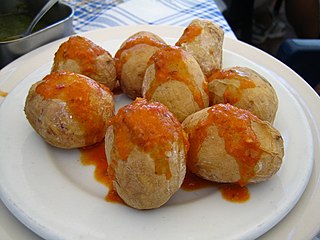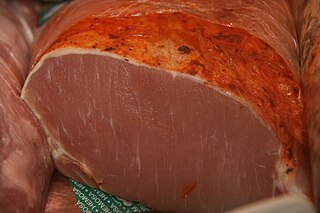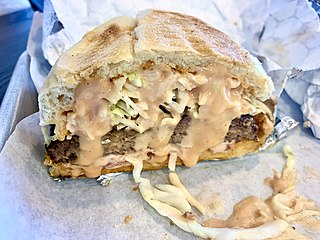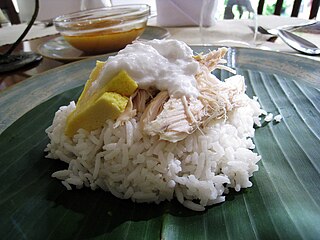History and influences
In the 1950's, following the Cuban Revolution, a significant influx of Cuban refugees to South Florida spurred the development of Floribbean cuisine. Early advocates were characterized by the so-called "Mango Gang," a group of South Florida chefs that included Norman Van Aken, Mark Militello, Douglas Rodriguez, and Allen Susser, who advocated the use of fresh local ingredients with Caribbean influences. [1] [2] Following a second influx of Cuban immigrants in the 1980s, these chefs and others in the state formalized Floribbean cuisine. [1] It is influenced by Latin American cuisine, Caribbean cuisine, Cuban cuisine, Soul food, Jamaican cuisine, Puerto Rican cuisine, Haitian cuisine, Bahamian cuisine, Jewish cuisine, and Asian cuisine. [1] According to Van Aken, Floribbean cuisine was an inspiration for modern fusion cuisine, having coined the phrase in a 1988 letter describing his plan to “salvage the golden treasures and vibrant calypso flavors of old Key West and fusing them with a contemporary sensibility and an individual personality". [2]
Typical features of Floribbean cuisine include an emphasis on fresh ingredients and complex medleys of spices, especially strong flavors offset by milder ones. [3] Floribbean cooking often uses less spicy heat than the Caribbean dishes that inspire it, but there is extensive use of several kinds of peppers. This pungency, however, is almost always moderated by the use of mango, papaya, rum, almond, coconut, key lime, or honey. [3]
As Floribbean cuisine evolved in South Florida it was strongly influenced by Asian culinary principles emphasizing the use of locally harvested Asian fruits and vegetables that will grow only in tropical and subtropical parts of the continental United States, where it rarely freezes. [4] [5]
Latin-Floribbean cuisine mixes Floribbean cuisine with Latin-American cuisine, resulting in strong Cuban, Puerto Rican, and Dominican influences. [6]

American cuisine consists of the cooking style and traditional dishes prepared in the United States. It has been significantly influenced by Europeans, Indigenous Americans, Africans, Latin Americans, Asians, Pacific Islanders, and many other cultures and traditions. Principal influences on American cuisine are European, Native American, soul food, regional heritages including Cajun, Louisiana Creole, Pennsylvania Dutch, Mormon foodways, Texan, Tex-Mex, New Mexican, and Tlingit, and the cuisines of immigrant groups such as Chinese American, Italian American, Jewish American, Greek American and Mexican American. The large size of America and its long history of immigration have created an especially diverse cuisine that varies by region.

A cuisine is a style of cooking characterized by distinctive ingredients, techniques and dishes, and usually associated with a specific culture or geographic region. Regional food preparation techniques, customs, and ingredients combine to enable dishes unique to a region.

Caribbean cuisine is a fusion of West African, Creole, Amerindian, European, Latin American, Indian/South Asian, Chinese, North American, and Middle Eastern cuisines. These traditions were brought from many countries when they moved to the Caribbean. In addition, the population has created styles that are unique to the region.

Fusion cuisine is a cuisine that combines elements of different culinary traditions that originate from different countries, regions, or cultures. Cuisines of this type are not categorized according to any one particular cuisine style and have played a part in many contemporary restaurant cuisines since the 1970s.

Costa Rican cuisine is known for being mostly mild, with high reliance on fruits and vegetables. Rice and black beans are a staple of most traditional Costa Rican meals, often served three times a day. Costa Rican fare is nutritionally well rounded, and nearly always cooked from scratch from fresh ingredients. Owing to the location of the country, tropical fruits and vegetables are readily available and included in the local cuisine.

Puerto Rican cuisine consists of the cooking style and traditional dishes original to Puerto Rico. It has been primarily a fusion influenced by the ancestors of the Puerto Rican people: the indigenous Taínos, Spanish Criollos and sub-Saharan African slaves. As a territory of the United States, the culinary scene of Puerto Rico has also been moderately influenced by American cuisine.

Fried rice is a dish of cooked rice that has been stir-fried in a wok or a frying pan and is usually mixed with other ingredients such as eggs, vegetables, seafood, or meat. It is often eaten by itself or as an accompaniment to another dish. Fried rice is a popular component of East Asian, Southeast Asian and certain South Asian cuisines, as well as a staple national dish of Indonesia. As a homemade dish, fried rice is typically made with ingredients left over from other dishes, leading to countless variations. Fried rice first developed during the Sui dynasty in China.

Latin American cuisine is the typical foods, beverages, and cooking styles common to many of the countries and cultures in Latin America. Latin America is a highly racially, ethnically, and geographically diverse with varying cuisines. Some items typical of Latin American cuisine include maize-based dishes arepas, empanadas, pupusas, tacos, tamales, tortillas and various salsas and other condiments. Sofrito, a culinary term that originally referred to a specific combination of sautéed or braised aromatics, exists in Latin American cuisine. It refers to a sauce of tomatoes, roasted bell peppers, garlic, onions and herbs. Rice, corn, pasta, bread, plantain, potato, yucca, and beans are also staples in Latin American cuisine.

Mojo is the name, or abbreviated name, of several types of sauces, varying in spiciness, consisting primarily of olive oil, local pepper varieties, garlic, paprika, cumin or coriander, and other spices. Mojo originated in the Canary Islands, where the main varieties are green mojo, red mojo, and spicy red mojo. Other countries have recipes similar to mojo, where acidic ingredients such as vinegar, lemon, orange, or lime juice may be used.

Adobo or adobar is the immersion of food in a stock composed variously of paprika, oregano, salt, garlic, and vinegar to preserve and enhance its flavor. The Portuguese variant is known as carne de vinha d'alhos. The practice, native to Iberia, was widely adopted in Latin America, as well as Spanish and Portuguese colonies in Africa and Asia.

Sofrito, sofregit, soffritto, or refogado, is a basic preparation in Mediterranean, Latin American, Spanish, Italian and Portuguese cooking. It typically consists of aromatic ingredients cut into small pieces and sautéed or braised in cooking oil for a long period of time over a low heat.

Dominican cuisine is made up of Spanish, indigenous Taíno, Middle Eastern, and African influences. The most recent influences in Dominican cuisine are from the British West Indies and China.

Piper auritum is an aromatic culinary herb in the pepper family Piperaceae, which grows in tropical Central America. Common names include hoja santa, yerba santa, hierba santa, Mexican pepperleaf, acuyo, tlanepa, anisillo, root beer plant, Vera Cruz pepper and sacred pepper.

Haitian cuisine consists of cooking traditions and practices from Haiti. It is a Creole cuisine that originates from a blend of several culinary styles that populated the western portion of the island of Hispaniola, namely African, French, indigenous Taíno, Spanish and Arab influences. Haitian cuisine has some similarities with "criollo" cooking and similar to the rest of the Caribbean, but differs in several ways from its regional counterparts. Flavors are bold and spicy demonstrating African and French influences, with notable derivatives coming from native Taíno and Spanish techniques.

Coconut rice is a dish prepared by cooking white rice in coconut milk or coconut flakes. As both the coconut and the rice-plant are commonly found in the tropics all around the world, coconut rice, too, is found in many cultures throughout the world, spanning across the equator from Southeast Asia, the Indian subcontinent, South America, Central America, West Africa, East Africa, the Caribbean and Oceania.
The global cuisine or world cuisine is a cuisine that is practiced around the world. A cuisine is a characteristic style of cooking practices and traditions, often associated with a specific region, country or culture. To become a global cuisine, a local, regional or national cuisine must spread around the world, its food served worldwide. There have been significant improvements and advances during the 20th century in food preservation, storage, shipping and production, and today many countries, cities and regions have access to their traditional cuisines and many other global cuisines.
Southern fusion is a fusion cuisine that blends or combines cuisine elements from the American southern states or other cultures with traditional Southern cooking. The origin of Southern fusion took place before there was a defining phrase for this pattern of cooking. Traditional southern food has originated from African, European and Hispanic cultures. Due to this fact, Southern fusion usually occurs naturally between different regions and cultures through immigration. Southern fusion cuisine can mean a blend of various Southern styles of cooking, or a blend of Southern style with another style of cooking altogether. Prevalent Southern fusion cuisines include Tex-Mex, although there are countless combinations of cuisines that would fall under the category of Southern fusion. Many modern restaurants in the southern states feature elements of Southern fusion cooking.

















